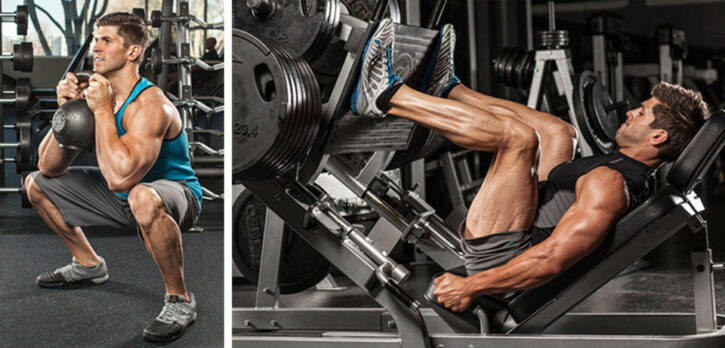To work out harder and longer, you need to build your endurance. However, endurance means a lot of different things to different people. To runners, it means being able to run for a long time, covering many miles. To weightlifters, it might mean being able to lift heavyweight for a lot of reps. Or to athletes, it can mean getting through an entire practice or game without needing to rest.
No matter the setting, endurance refers to your ability to carry out any given physical task for an extended time. Two parts of your body — your heart and your muscles — both contribute to giving you endurance. While they are both critical in helping your body go the distance, knowing the difference between cardio and muscular endurance is key to reaching your fitness goals.
What is cardiovascular endurance?

Cardiovascular or cardiorespiratory endurance is what most people mean when they refer to endurance in general. Cardiovascular endurance is the ability of your cardiopulmonary system (heart and blood vessels; lungs and airways) to keep your body active for an extended time.
Most people mean “aerobic fitness” when they talk about endurance. During aerobic exercise, your body uses oxygen to supply your working muscles with energy. This type of activity can be performed for hours on end, depending on how conditioned you are.
People often picture marathon runners and Olympic swimmers when they think of people who have good endurance because those activities require a high level of aerobic conditioning. However, elite athletes also have high muscular endurance, a lesser-known, but equally as important, part of fitness.
Cardiovascular endurance is mostly associated with long-distance sports like marathon running.
What is muscular endurance?

The exact definition of muscular endurance is “the ability of a muscle or muscle group to perform repeated contractions against a load for an extended period.”
In plain talk, that means the number of reps you can perform any given exercise without failing or breaking your form. Conventional muscular endurance tests include doing as many push-ups, squats, and pull-ups that you can, before being physically unable to continue. Still, muscular endurance is also essential for hiking, running, swimming, and high-volume weightlifting.
Which one is better?

Surprise: neither is better than the other. Cardio endurance and muscular endurance intertwine to promote an optimal level of health and fitness.
Take running, for example. You need good cardio endurance so that your heart and lungs can continue working efficiently and make sure your muscles get enough oxygen throughout your run. It would be best if you also had muscular endurance to complement cardiovascular endurance to ensure that your legs don’t give out on you, especially when running on rough or hilly terrain.
For instance, you also use both types of endurance during everyday activities, like walking up a few flights of stairs. And muscular endurance is essential for many outdoor activities, including hiking.
How to build cardio endurance

When it comes to cardio, there’s nothing to it but to do it. You can’t weasel your way out of building cardiovascular endurance: You have to put in the work. This means going running, biking, and hiking; climbing stairs and sprinting intervals; doing things that make you sweat heavily, and breathe hard.
Steady-state cardio and interval-based cardio help build cardio endurance, and it’s best to incorporate both into your training plan. Slow, long-distance training is the most common form of endurance training, and it’s what marathon runners primarily use to stay in shape for their races.
You can also build cardio endurance with tempo training, Fartlek training, and sprint workouts.
Track it
Cardio exercise is by far the most straightforward form of exercise to track because it’s primarily distance or time-based. The wealth of and exercise-logging apps make it so easy to keep track of cardiovascular endurance.
For running, walking, biking, and hiking, you can use your fitness watch or virtually any distance-based activity app.
You can also use perceived exertion to measure cardio endurance. Pick a workout — for the sake of an example, let’s use a 5 km run — and complete it with an all-out effort. If you log your first test as “5 km run, 30 minutes, felt very hard,” and your second test, three months later, as “5 km, 27 minutes, felt very hard,” you know you improved.
Even though both tests were very hard, your time lets you know that your all-out effort for a 5 km is now faster.
How to build muscular endurance

You build muscular endurance primarily through resistance training. You can effectively build muscular endurance through bodyweight training, weightlifting, and the use of resistance cables and bands — anything that involves contracting your muscles against resistance will improve your muscles’ endurance.
The critical thing to remember is that training for muscular endurance is different than training for muscular strength. To train for endurance, you should lift lighter loads for more reps; to train for strength, lift heavier loads for fewer reps.
Track it
Keeping tabs on your muscular endurance is, naturally, more difficult than keeping track of cardiovascular endurance. You can’t measure muscular endurance explicitly in terms of distance, speed, or time, though those metrics can certainly help.
Tracking muscular endurance is more segmented by body parts and is often based on effort. For example, you can test your lower body’s muscular endurance by performing as many bodyweight squats as possible before breaking the form.
You can test the muscular endurance of your upper body by performing as many push-ups as possible before your form breaks (your core collapses, shoulders start to pull apart, or you fail a rep).
Test your muscular endurance by repeating a move, like a push-up, until you can’t do it with correct form anymore.
Retest these movements periodically, such as every three to six months, to see if you improve.
If you’re more advanced, you can do a weighted test for muscular endurance. For example, consider your baseline test a set of 20 barbell back squats (bar resting on your shoulders) at 100 pounds. Perform the 20 reps at an all-out effort and note these metrics:
- How long the 20 squats took;
- How many reps were the perfect form;
- And how you felt during and after the set ratings of perceived exertion.
Let’s say I did this test, and it took me 60 seconds to complete all 20 reps, and by the eighth rep, my form was dwindling. If I retest in three months and take 50 seconds, and all 20 reps are perfect, my muscular endurance has improved.
I hope you found this article helpful and informative. If you have anything you’d like to share or any opinions about my website, please speak up. I look forward to your comments, questions, and the sharing of ideas.
Related articles:
ProForm SMART Endurance 920 E | Best Elliptical under $1,000
Disclaimer: I am not a personal trainer or a healthcare professional. The information contained in this article is for educational and informational purposes only. It’s not intended as health or medical advice. Always consult a physician or other qualified health provider regarding any questions you may have about a medical condition or health objectives.
Great article! I’ve always mixed these two up. I never really thought about the differences. This was a beautiful, concise, and clear explanation. I will adjust my thinking accordingly. I will continue building my cardio endurance as usual with my walking and biking. But now I will add a program to build muscular endurance as well. Maybe some bodyweight exercises? Thanks a lot. Mark.
Hey Mark, bodyweight exercises are great for building muscular endurance.
All the best
Robert
Wow, there is so much to learn here regarding endurance, and reading this has been helpful to me because I can learn what I didn’t know. I was once an athlete, and I know that endurance is going the distance without having to slow down it take a rest, but I didn’t know about the different types of endurance that there is. This was a perfect read for me. Thanks!
Your welcome, Jay. What sport did you play as an athlete?
Robert